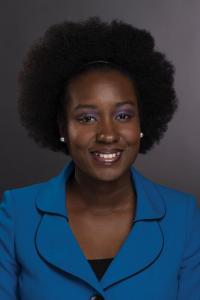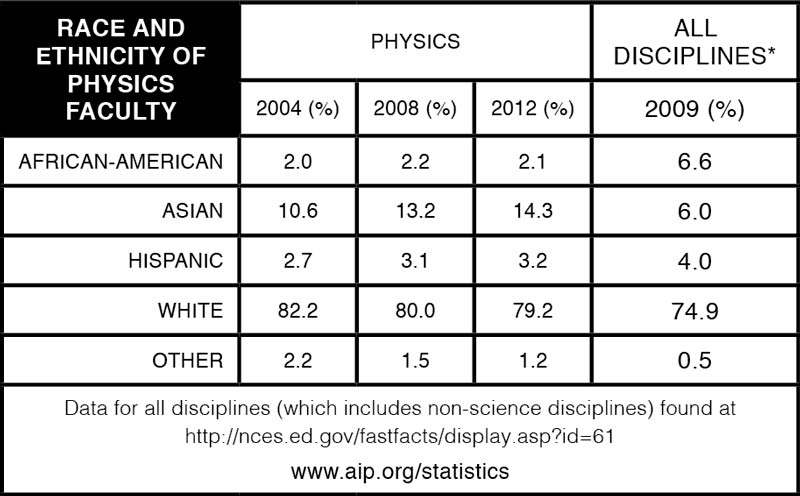Understanding and Promoting Diversity and Inclusion in Physics
Winter
2017
Pathways - Advice from Experienced Voices
Understanding and Promoting Diversity and Inclusion in Physics
Geraldine L. Cochran, PhD – Dean of the Douglass Project for Rutgers Women in Math, Science, & Engineering, Rutgers
 Have you met someone who approached things differently than you and it seemed to perfectly complement the way you think? Maybe that person seemed to have the missing piece to the puzzle you were striving to solve. I can recall, as an undergraduate, staying up all night working on a problem in my mathematical methods course. I went to sleep dreaming about the problem, and when I woke up, I would make some headway but just could not seem to finish the problem. I was missing that last step. I discussed the problem with a friend who said she had difficulties with how to start the problem, but she was able to finish it easily. I now realize that it takes all types of people, from various backgrounds and perspectives, to solve the toughest problems. To some extent, I think we all value diversity in our lives, and it is important to bring the notion of diversity and inclusivity into all facets of the physics community, as well as within our everyday lives.
Have you met someone who approached things differently than you and it seemed to perfectly complement the way you think? Maybe that person seemed to have the missing piece to the puzzle you were striving to solve. I can recall, as an undergraduate, staying up all night working on a problem in my mathematical methods course. I went to sleep dreaming about the problem, and when I woke up, I would make some headway but just could not seem to finish the problem. I was missing that last step. I discussed the problem with a friend who said she had difficulties with how to start the problem, but she was able to finish it easily. I now realize that it takes all types of people, from various backgrounds and perspectives, to solve the toughest problems. To some extent, I think we all value diversity in our lives, and it is important to bring the notion of diversity and inclusivity into all facets of the physics community, as well as within our everyday lives.
So, what is diversity and inclusion?
Though most understand the value and importance of diversity and inclusion, historical, political, and societal contexts have led to diversity being a challenge for individuals, fields, and institutions, particularly when it comes to certain aspects of diversity, such as race, ethnicity, gender, sexual orientation, socioeconomic status, religion, and ability. So, what is the difference between diversity and inclusion? Diversity is having a whole—an organization, an institution, a field—composed of parts that are different. Inclusion, though, is different than diversity. I often think of an inclusive environment as one in which members feel welcome, supported, and valued by the other members of the community. Namandje Bumpus takes it a step further, noting that, “Inclusion speaks to whether individuals have equal access to opportunities and empowerment.”1 An inclusive environment is certainly not one in which members feel isolated. It is not an environment where anyone is made to feel that their only contribution to the community is their race/ethnicity, gender, or sexual orientation—in other words, tokenization. Within the physics community, diversity and inclusion means attracting underrepresented communities to physics academia and careers, and making strides to ensure that various groups feel welcomed and accepted into our great community. Our physics community should be representative of our everyday community: diverse.
Is the physics community diverse?
In general, the physics community is not as diverse as we collectively would like; however, great strides have been made to improve our local environment. According to the Statistical Research Center of the American Institute of Physics (AIP), 20 percent of bachelor’s degrees awarded in 2014 in physics went to women,2 though women represented approximately 51 percent of the population.3 This denotes the underrepresentation—one measure of diversity—of women in physics at the bachelor’s degree level. African Americans earned just over 2 percent of physics and astronomy doctoral degrees and Hispanics between 3 and 4 percent in 2012, also denoting underrepresentation.4 This underrepresentation in degree attainment naturally leads to underrepresentation in the workforce. The table at right illustrates the underrepresentation of ethnic/racial minorities among physics faculty.
More work to actively encourage diversity among the physics community at all levels needs to be accomplished. I would encourage reviewing reports produced by AIP’s Statistical Research Center (www.aip.org/statistics) to understand what diversity and representation are like in the field of physics at various levels.
To illuminate the tremendous strides we’ve made towards a more diverse physics community, I’ve provided a few examples of fantastic physicists who have brought to light issues surrounding ethnic/racial minorities, gender equality, and LGBTQIA persons in physics. I am encouraged by the work of Jedidah Isler, the first African American woman to receive a PhD in astrophysics from Yale, to support women of color in a variety of scientific fields through Vanguard STEM,5 the work of Jami Valentine, the first African American woman to receive a PhD in physics from Johns Hopkins University, who founded a website dedicated to African American women in physics, AAWiP,6 the service of Chanda Prescod-Weinstein, who created and manages a virtual space for black women in physics and astronomy to build community and serve as resources for each other; the efforts of Ximena Cid, the first Native American (Yaqui) to graduate with a PhD in physics from UT Arlington, to support Latinx, Native, and other ethnic/racial minority students in physics through physics education research and leadership in physics professional societies; the work of Ramón Barthelemy, who utilizes his expertise in research design, statistical research, and physics education research to bring to light some of the challenges faced by women, ethnic/racial minorities, and LGBTQIA persons in physics through evidence; and the leadership of Brittany Kamai, one of only five Native Hawaiians and the second Native Hawaiian woman to earn a PhD in physics, who serves as a mentor to diverse groups of students in astrophysics and has served on advisory boards to improve bridge programs for students. I am encouraged by the rise of bridge programs in physics designed to provide support to ethnic/racial minorities, women, and students from low-socioeconomic backgrounds to overcome economic, societal, and educational disadvantages that might otherwise serve as barriers to them obtaining graduate degrees in physics, while also working to make structural changes that might remove some of those barriers completely. Again, this list is not exhaustive, but it includes a few people who have recently encouraged and inspired me to be more active in my pursuit of making physics more diverse and more inclusive.
Is the physics community inclusive?

Inclusivity is a newer concept than diversity and, I believe, based on research and actions evidence gathered during discussions with physicists in a variety of settings, that there is still much work to be accomplished to make our community a holistically inclusive one. Many great physicists have already contributed to the body of work towards increasing inclusivity. If you are interested in learning more about gender discrimination and gender microaggressions (the everyday verbal, nonverbal, and environmental intentional or unintentional anecdotes that can communicate hostility and malice towards underrepresented populations), I encourage you to review the work of Barthelemy, McCormick, and Henderson7 on gender discrimination in physics and astronomy, with a focus on sexism and gender microaggressions experienced by graduate students. Rosa and Mensah8 also provide a great synthesis on black women physicists and overcoming obstacles in their pursuit of graduate degrees in physics. The review on gender in physics education research conducted by Traxler, Cid, Blue, and Barthelemy,9 and other articles in the Physics Review Physics Education Research journal’s Focused Collection on Gender in Physics, also provides an informative stance on gender in physics. I would also encourage a review of the LGBT Climate in Physics study published by the American Physical Society.10 For more information on this study, reference the “Queer Physicists Speak Out” article in this issue. This is certainly not an exhaustive review of the literature, but rather some of the literature that I’ve recently reviewed that speaks to inclusion in the physics community. Though there is a lot of work to be done to create an inclusive environment within the field of physics across multiple levels (i.e., undergraduate, graduate), in multiple institutions (within academia and at national labs), and for persons with a variety of identities (i.e., ethnic/racial minorities, women, persons with disabilities, and LGBTQIA persons), I am not discouraged. In fact, I am encouraged because I find myself frustrated lately—not by the lack of opportunities to promote diversity and inclusion in physics, but rather by the time constraints that prevent me from taking advantage of the many opportunities to participate actively in these initiatives.
So, What Can you do?
I do hope that all of you will explore the work of those mentioned if you’re not already familiar with it. Seek to get to know these amazing physicists and others, and you’ll find yourself reinvigorated and more inspired to also actively work toward making physics diverse and inclusive at all levels and in all settings. Who better to take on the cause of increasing diversity in physics and creating an inclusive physics community other than physicists? I think most will agree with me that physicists are thought to be some of the greatest minds in the world, some of the best problem solvers. Naturally, then, physicists are well positioned to make physics a diverse and inclusive field. Albert Einstein, no doubt one of the most famous physicists, took a stand against racism and engaged in activism.11 May we follow his leadership in enjoying the study and pursuit of physics while also working to make physics a diverse and inclusive environment. //
1. Bumpus, N. (2015). Moving toward inclusion. DOI: 10.1126/science.caredit.a1500273.
2. Mulvey, P. J., & Nicholson, S. (2012). Physics Bachelor’s Degrees, Focus On. American Institute of Physics Statistical Research Center, College Park, MD.
3. US Census Bureau (2015).
4. Ivie, Anderson, & White (2014). African Americans & Hispanics Among Physics & Astronomy Faculty: Results from the 2012 Survey of Physics & Astronomy Degree-Granting Departments. American Institute of Physics Statistical Research Center, College Park, MD. (https://www.aip.org/sites/default/files/statistics/faculty/africanhisp-f...)
5. http://vanguardstem.com/author/jedidah-isler-phd/.
6. Valentine, J. M., & Tucker, J. (2016). African American Women in Physics. http://www.aawip.com.
7. Barthelemy, R. S., McCormick, M., & Henderson, C. (2016). Gender discrimination in physics and astronomy: Graduate student experiences of sexism and gender microaggressions. Physical Review Physics Education Research, 12(2), 020119.
8. Rosa, K., & Mensah, F. M. (2016). Educational pathways of black women physicists: Stories of experiencing and overcoming obstacles in life. Physical Review Physics Education Research, 12(2), 020113.
9. Traxler, A. L., Cid, X. C., Blue, J., & Barthelemy, R. (2016). Enriching gender in physics education research: A binary past and a complex future. Physical Review Physics Education Research, 12(2), 020114.
10. Atherton, T. J., Barthelemy, R. S., Deconinck, W., Falk, M. L., Garmon, S., Long, E., Plisch, M., Simmons, E. H., & Reeves, K. (2016). LGBT Climate in Physics: Building an Inclusive Community. American Physical Society, College Park, MD.
11. Jerome, F., & Taylor, R. (2006). Einstein on Race and Racism. Rutgers University Press, New Brunswick, NJ.
